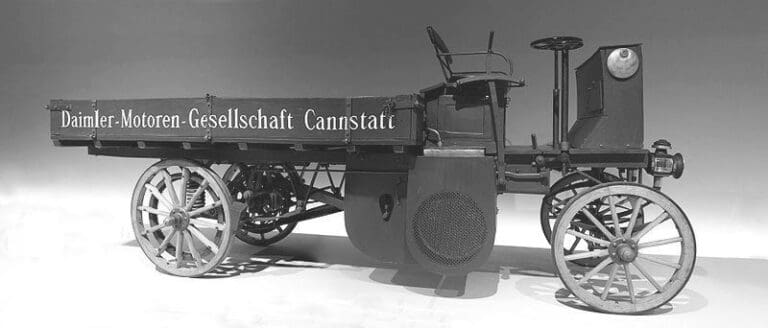A brief history of the progress and development of trucking in the U.S.
The history of road transportation in the United States is a tale of technological progress and labor development spanning over a century. From the early trucks that emerged in the late 19th century to the present day, this evolution has been a narrative of innovation, regulation, and adaptation. Road transportation is a vital component of American commerce, with a rich history intertwined with the nation’s growth; the industry is responsible for supplying 70% of all goods reaching the market.
1896: birth of the truck
The roots of road transportation trace back to the development of steam wagons in the late 19th century. However, it was in 1896 that inventor Gottlieb Daimler took this concept a step further by transforming a horse-drawn carriage, equipping it with a two-cylinder, four-horsepower engine designed from a modified touring car engine. Subsequently, in 1900, brothers Jack and Gus Mack founded the company that would become Mack Trucks, a pioneer in the modern road transportation industry.

1910: the first modern truck
In 1914, Otto Neumann and August Fruehauf developed the semi-trailer, followed in 1915 by the introduction of the fifth wheel by Hermann Farr and Martin Rocking, enabling a secure coupling between semi-trailers and trailers.
1920: road transportation expands
During the 1920s, there was a significant increase and progress in the realm of road transportation in the United States, driven by the expansion of paved roads. This improvement in infrastructure allowed trucks to become an effective alternative to railroads for freight transportation.
1940: trucks for the war
During World War II, American trucks were essential for transporting troops and supplies. The post-World War II economic boom propelled American road transportation into the modern era.
The road transportation industry experienced rapid growth due to advancements such as powerful diesel engines, refrigerated containers, and the expansion of the road network. After the war, trucks became the primary method of transporting goods and products, surpassing trains for the first time since the completion of the Transcontinental Railroad in 1869.

1970: golden age of road transportation
In the 1970s, there was a boom in trucking culture, portraying truck drivers as modern rebels. This decade laid the groundwork for the contemporary era of road transportation, with increased competitiveness and its essential role in the American economy.

2000: decade of innovation
During the 2000s, regulations on engine emissions were tightened, led by the EPA to address the impact of diesel exhaust on public health, resulting in significant changes in engine technology and emissions control. The decade also witnessed an increased pursuit of new innovations to enhance truck power, especially for heavy vehicles that experienced significant growth in popularity.
2016: first autonomous driving truck
In October 2016, a milestone was witnessed: a truck transported 2,000 cases of Budweiser over a 120-mile journey. This type of delivery had been carried out countless times by truckers, but this time there was no driver. In collaboration with Anheuser-Busch, a new company called Otto deployed one of its self-driving trucks on a successful mission, presented as a glimpse of a future without the need for truck drivers.

2020: zero emissions and autonomous trucks
In this new decade, the sector has experienced advances in autonomous transportation technologies, although widespread adoption and regulatory frameworks are still evolving. There has been a greater emphasis on reducing carbon emissions and exploring sustainable and eco-friendly technologies for road transportation, in line with global environmental objectives.
Innovations continue, and the story continues to unfold. What does the future hold for the road transportation industry in the coming years?

The story of the first car race in Paris: a historic hit in 1894
Paris stands not only as a cultural and artistic epicenter but also as a pioneer in car racing In the history of automotive racing, Paris

Top states for driving in the United States in 2024
A WalletHub study compared all 50 states to determine the best driving conditions Road safety and quality are central concerns for drivers. And while the

Briefs: marijuana reclassification, vehicle fees, and climate grants
The trucking industry goes through new legislation, taxes and subsidies Questions about the proposed reclassification of marijuana The Owner-Operator Independent Drivers Association (OOIDA) supports the

Impact of traffic pollution: study reveals increase in blood pressure
A study from the University of Washington in Seattle reveals that the main cause of significant increases in blood pressure might be traffic-related gasses A

The benefits and careers of a Commercial Driver’s License
Having a CDL opens multiple doors within the trucking and transportation industry Having a Commercial Driver’s License (CDL) opens multiple doors within the trucking industry,

Sharing the road with a truck: steps to ensure your safety
Caution around blind spots and anticipating truck maneuvers are essential to ensuring everyone’s safety Truck drivers face significant challenges on the road due to their
